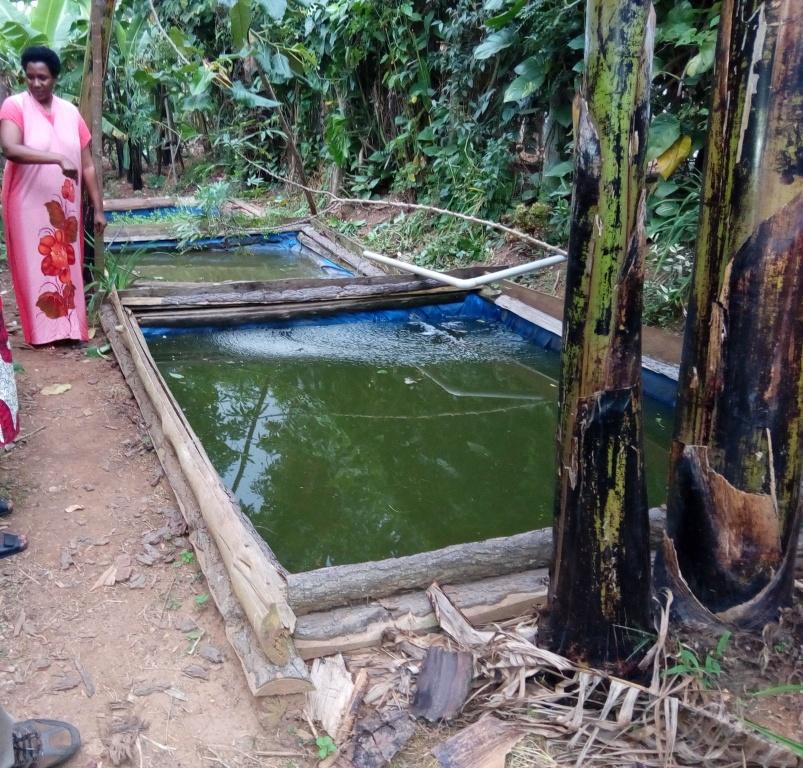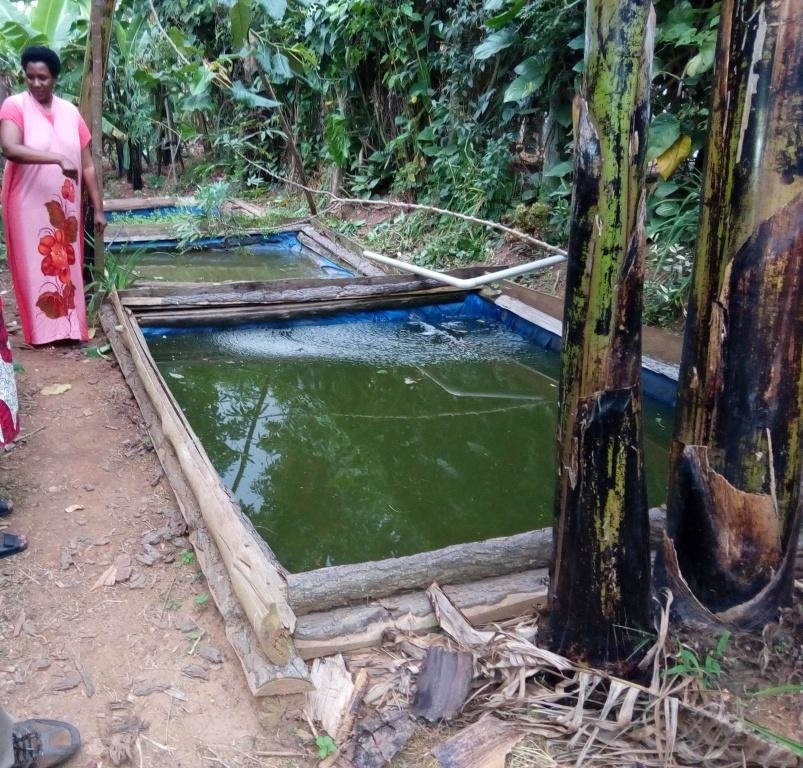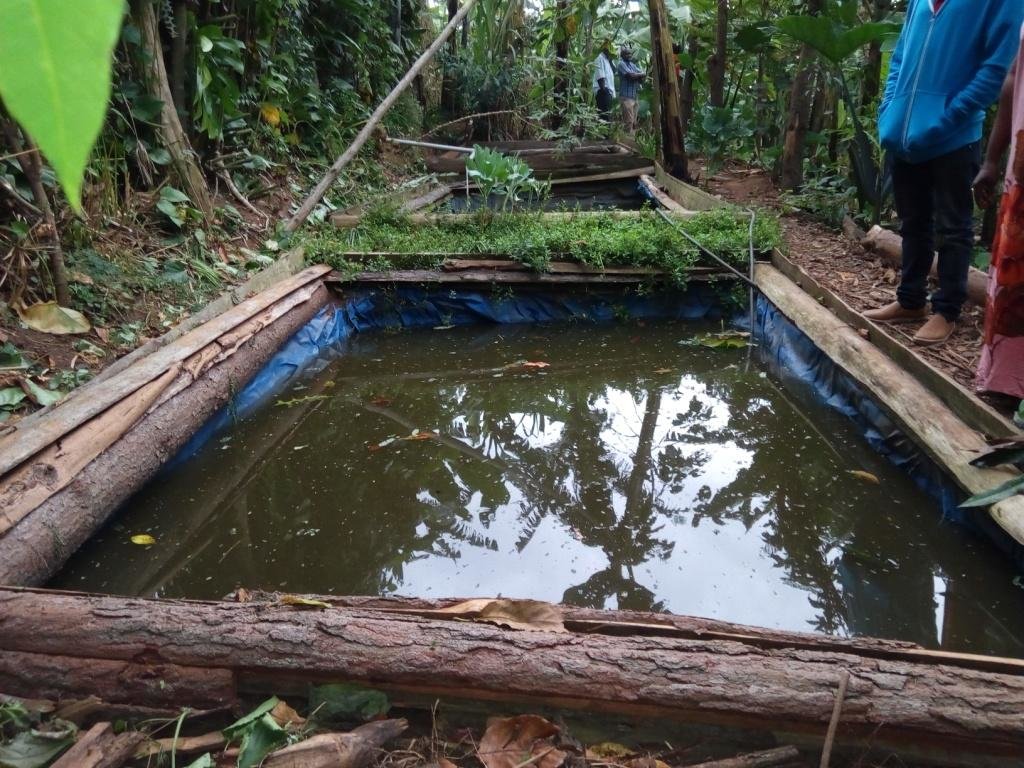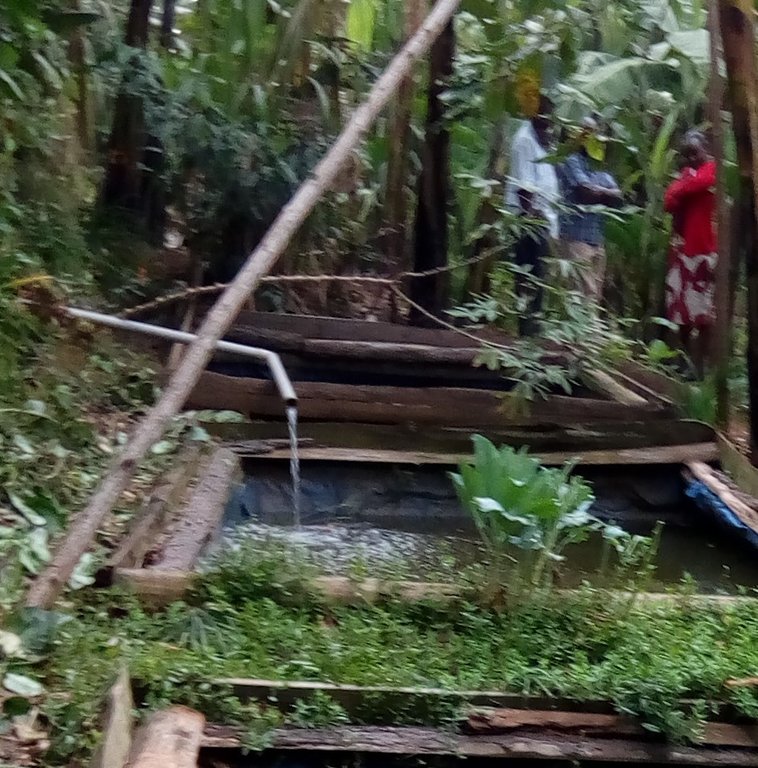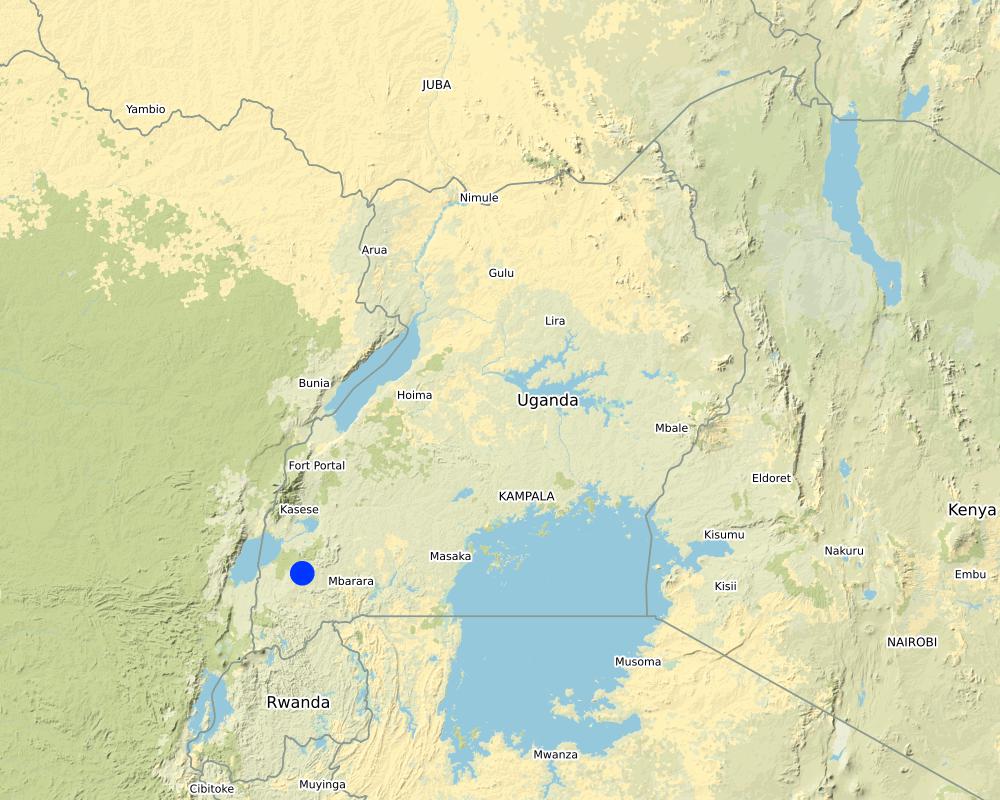Backyard fish farming in tarpaulin ponds for improved livelihood [ยูกันดา]
- ผู้สร้างสรรค์:
- การอัพเดท:
- ผู้รวบรวม: Aine Amon
- ผู้เรียบเรียง: Drake Mubiru, Kamugisha Rick Nelson
- ผู้ตรวจสอบ: Nicole Harari, Udo Höggel
Okutunga Ebyenyanja omu ntundubale
technologies_3391 - ยูกันดา
ดูส่วนย่อย
ขยายทั้งหมด ย่อทั้งหมด1. ข้อมูลทั่วไป
1.2 รายละเอียดที่ติดต่อได้ของผู้รวบรวมและองค์กรที่เกี่ยวข้องในการประเมินและการจัดเตรียมทำเอกสารของเทคโนโลยี
วิทยากรหลัก
ผู้ใช้ที่ดิน:
David Mawanda
Uganda, Bushenyi, Kagoma
ยูกันดา
ชื่อของโครงการซึ่งอำนวยความสะดวกในการทำเอกสารหรือการประเมินเทคโนโลยี (ถ้าเกี่ยวข้อง)
Scaling-up SLM practices by smallholder farmers (IFAD)ชื่อขององค์กรซึ่งอำนวยความสะดวกในการทำเอกสารหรือการประเมินเทคโนโลยี (ถ้าเกี่ยวข้อง)
National Agricultural Research Organisation (NARO) - ยูกันดา1.3 เงื่อนไขการใช้ข้อมูลที่ได้บันทึกผ่านทาง WOCAT
วันที่เก็บรวบรวมข้อมูล(ภาคสนาม) :
23/01/2018
ผู้รวบรวมและวิทยากรหลักยอมรับเงื่อนไขเกี่ยวกับการใช้ข้อมูลที่ถูกบันทึกผ่านทาง WOCAT:
ใช่
1.4 การเปิดเผยเรื่องความยั่งยืนของเทคโนโลยีที่ได้อธิบายไว้
เทคโนโลยีที่ได้อธิบายไว้นี้เป็นปัญหาของความเสื่อมโทรมโทรมของที่ดินหรือไม่ จึงไม่ได้รับการยอมรับว่าเป็นเทคโนโลยีเพื่อการจัดการที่ดินอย่างยั่งยืน:
ไม่ใช่
2. การอธิบายลักษณะของเทคโนโลยี SLM
2.1 การอธิบายแบบสั้น ๆ ของเทคโนโลยี
คำจำกัดความของเทคโนโลยี:
A fish pond for intensive commercial fish farming is constructed in the backyard of the farmer's home for easy management. The pond is lined with a tarpaulin interior and is connected to a water source for water supply during the seasons of water scarcitiy.
2.2 การอธิบายแบบละเอียดของเทคโนโลยี
คำอธิบาย:
The backyard fish pond farming system is a simple commercial fish farming system established close to the farmers’ home stead. It is planned to ease management of rearing the fish and to minimize maintenance costs. The system is also designed to harvest rain water and overflow which eases filling and emptying of the pond with water. The walls of the ponds are lined with tarpaulin and the banks are strengthened with timber or brick work to prevent breaking of the walls. The three ponds in Bushenyi-Kigoma are located on a gentle slope and designed with a trench that feeds them with rain water from the rain harvest reservoir up slope. They were constructed in 2013 and are located a meter away from a live fence enclosing the farmer’s house. This makes it easy for the farmer to access, monitor and manage the fish ponds.
The establishment process for each pond is simple and may not require technical skills to set up the system. The activities involved include:
i.Excavation of the pond, which is best done during the dry season to avoid interruption by runoff.
ii.Strengthening of banks using timber and nails (some farmers use brinks, cement and sand)
iii.Lining of the water proof tarpaulin on the interior of the pond.
iv.Construction of a water channel from the water reservoir to the pond and fixing of overflow pipes at the deeper end of the ponds.
v.Filling the pond with water and applying animal dug to fertilize the ponds. This creates a favorable environment for growth of microorganisms and algae on which fish can feed.
vi.The fish fingerlings are introduced into the pond two weeks after fertilization with animal dug.
The maintenance activities include; cleaning of ponds from contamination of objects, changing of the pond water on a monthly basis to avoid contamination that may lead to infestation and application of organic fertilizers.
Establishment requires a hoe, panga, dibber, spade, wheel barrow, hammer and the trowel. The inputs include; timber, tarpaulin, cement, garters bricks, sand, nails, plastic pipe, water, animal dung, fish pellets and fish fingerlings. These where used to construct a pond 5 m × 4 m × 3 m i.e length × width × depth respectively, with a maximum carrying capacity of 500 cat fish.
The costs of setting up the system are relatively affordable to the average local people according to the farmer. The key determinants are hiring labor to excavate the ponds, construction of a water channel and stocking fish fingerlings which are all locally available. The maintenance activities involve daily feeding of fish, cleaning in case of contamination, changing the pond water every 3 months and harvesting of fish at 7 months of age. The farmer spends USD $ 164.65 on establishment of the pond system including, exaction costs, equipment, materials and stocking fingerlings (USD $ 0.033 each). The farmer spends USD$ 21.99 on premixed feeds before harvesting the fish after seven months. The cat fish are harvested with 3-5 kg liveweight after 7 months and sold at USD$ 2.75 to wholesale buyers from Kasese District.
The intensive fish farming system is designed to demand minimal labor for feeding the fish, cleaning the pond, replacing water and harvesting fish. The system is also adapted to water scarcity in the dry season since it is connected to a rain water harvest system; regular changing of pond water improves visibility, removes algae, replenishes oxygen and minimizes possible infections in the pond.
2.3 รูปภาพของเทคโนโลยี
2.4 วีดีโอของเทคโนโลยี
ความคิดเห็น/อธิบายสั้นๆ:
The Video shows the set up of the ponds but does not include the farmer's house because of the live fence separating the ponds from the house.
วันที่:
24/01/2018
ชื่อผู้ถ่ายวีดีโอ:
Amon Aine
2.5 ประเทศภูมิภาค หรือสถานที่ตั้งที่เทคโนโลยีได้นำไปใช้และได้รับการครอบคลุมโดยการประเมินนี้
ประเทศ:
ยูกันดา
ภูมิภาค/รัฐ/จังหวัด:
Western Uganda, Bushenyi District
ข้อมูลจำเพาะเพิ่มเติมของสถานที่ตั้ง :
Nyabubare Sub county, Kigoma town
แสดงความคิดเห็น:
The farm is 6Km from Ishaka Bushenyi along Bushenyi-Rubirizi highway.
Map
×2.6 วันที่การดำเนินการ
ระบุปีที่ใช้:
2016
2.7 คำแนะนำของเทคโนโลยี
ให้ระบุว่าเทคโนโลยีถูกแนะนำเข้ามาอย่างไร:
- ด้วยการริเริ่มของผู้ใช้ที่ดินเอง
- ทางโครงการหรือจากภายนอก
ความคิดเห็น (ประเภทของโครงการ เป็นต้น) :
Intensive back yard fish farming.
3. การจัดประเภทของเทคโนโลยี SLM
3.1 วัตถุประสงค์หลักของเทคโนโลยี
- ปรับปรุงการผลิตให้ดีขึ้น
- ลด ป้องกัน ฟื้นฟู การเสื่อมโทรมของที่ดิน
- ลดความเสี่ยงของภัยพิบัติ
- ปรับตัวเข้ากับการเปลี่ยนแปลงภูมิอากาศของโลก สภาพภูมิอากาศที่รุนแรงและผลกระทบ
- สร้างผลกระทบทางด้านเศรษฐกิจที่เป็นประโยชน์
- Beauty
3.2 ประเภทของการใช้ที่ดินในปัจจุบันที่ได้นำเทคโนโลยีไปใช้

พื้นที่ปลูกพืช
- การปลูกพืชยืนต้นที่ไม่มีเนื้อไม้
พืชหลัก (พืชเศรษฐกิจและพืชอาหาร):
Bananas, yams and shrub fence
3.3 ข้อมูลเพิ่มเติมเกี่ยวกับการใช้ที่ดิน
การใช้น้ำของที่ดินที่มีการใช้เทคโนโลยีอยู่:
- น้ำฝนร่วมกับการชลประทาน
แสดงความคิดเห็น:
The farmer harvests roof top water and channels it into the ponds during times of water scarcity
จำนวนของฤดูเพาะปลูกต่อปี:
- 2
ระบุ:
March - May & Sept - Nov
ความหนาแน่นของปศุสัตว์ (ถ้าเกี่ยวข้อง):
500 fish per 5m×4m×3m in length, width and depth respectively
3.4 กลุ่ม SLM ที่ตรงกับเทคโนโลยีนี้
- การเลี้ยงผึ้ง การเพาะเลี้ยงสัตว์น้ำ สัตว์ปีก ฟาร์มกระต่าย ฟาร์มหนอนไหม
- สวนครัว
3.5 กระจายตัวของเทคโนโลยี
ระบุการกระจายตัวของเทคโนโลยี:
- ใช้ ณ จุดที่เฉพาะเจาะจงหรือเน้นไปยังบริเวณพื้นที่ขนาดเล็ก
3.6 มาตรการ SLM ที่ประกอบกันเป็นเทคโนโลยี

มาตรการอนุรักษ์ด้วยโครงสร้าง
- S5: เขื่อน ชั้นดินที่แน่นแข็งบ่อน้ำ
3.7 รูปแบบหลักของการเสื่อมโทรมของที่ดินที่ได้รับการแก้ไขโดยเทคโนโลยี

การเสื่อมโทรมของดินทางด้านกายภาพ
- Pu (Loss of bio-productive function): การสูญเสียหน้าที่การผลิตทางชีวภาพอันเนื่องมาจากกิจกรรม อื่นๆ

อื่น ๆ
แสดงความคิดเห็น:
The intensive method utilizes small space for high quantity fish production and therefore reduces the conversion of large pieces of land to fish farming
3.8 การป้องกัน การลดลง หรือการฟื้นฟูความเสื่อมโทรมของที่ดิน
ระบุเป้าหมายของเทคโนโลยีกับความเสื่อมโทรมของที่ดิน:
- ลดความเสื่อมโทรมของดิน
แสดงความคิดเห็น:
The design promotes intensive methods to utilize small space for high quantity fish production and therefore reduces the conversion of large pieces of land to fish farming.
4. ข้อมูลจำเพาะด้านเทคนิค กิจกรรมการนำไปปฏิบัติใช้ ปัจจัยนำเข้า และค่าใช้จ่าย
4.1 แบบแปลนทางเทคนิคของเทคโนโลยี
4.2 ข้อมูลจำเพาะด้านเทคนิคและการอธิบายแบบแปลนทางเทคนิค
The water ponds are constructed with 5m × 4m × 3 m i.e length × width × depth. The ponds are on a gentle slope a meter away from a live fence. The ponds are lined with a water proof tarpaulin. The banks are strengthened with wood fixed together with nails.
4.3 ข้อมูลทั่วไปเกี่ยวกับการคำนวณปัจจัยนำเข้าและค่าใช้จ่าย
ให้ระบุว่าค่าใช้จ่ายและปัจจัยนำเข้าได้รับการคำนวณอย่างไร:
- ต่อหน่วยเทคโนโลยี
โปรดระบุหน่วย:
Pond
ระบุปริมาตร ความยาว เป็นต้น (ถ้าเกี่ยวข้อง):
5m × 4m × 3 m i.e length × width × depth respectively
อื่นๆ หรือสกุลเงินประจำชาติ (ระบุ):
Ugandan shilling
ระบุอัตราแลกเปลี่ยนจากดอลลาร์สหรัฐเป็นสกุลเงินท้องถิ่น (ถ้าเกี่ยวข้อง) คือ 1 เหรียญสหรัฐ =:
3650.0
ระบุค่าเฉลี่ยของค่าจ้างในการจ้างแรงงานต่อวัน:
10,000
4.4 กิจกรรมเพื่อการจัดตั้ง
| กิจกรรม | ประเภทของมาตรการ | ช่วงเวลาดำเนินการ | |
|---|---|---|---|
| 1. | Excavation | ด้วยโครงสร้าง | In the dry season |
| 2. | Fixing of tarpaulin and timber on the banks | ด้วยโครงสร้าง | After excavation |
| 3. | Filling pond with water and fertilizing with animal dug | ด้วยการจัดการ | After fixing walls |
| 4. | Stocking the pond | มาตรการอื่น ๆ | 2 days after filling pond with water and fertilization |
| 5. | Connecting a water channel from the water reservoir with a pvc pipe at end the end leading to the pond | ด้วยโครงสร้าง | After excavation. |
4.5 ค่าใช้จ่ายของปัจจัยนำเข้าที่จำเป็นสำหรับการจัดตั้ง
| ปัจจัยนำเข้า | หน่วย | ปริมาณ | ค่าใช้จ่ายต่อหน่วย | ค่าใช้จ่ายทั้งหมดต่อปัจจัยนำเข้า | %ของค่าใช้จ่ายที่ก่อให้เกิดขึ้นโดยผู้ใช้ที่ดิน | |
|---|---|---|---|---|---|---|
| แรงงาน | Construction labour | man day | 5.0 | 50000.0 | 250000.0 | 100.0 |
| อุปกรณ์ | Hoe hire | per day | 500.0 | 5.0 | 2500.0 | 100.0 |
| อุปกรณ์ | Panga hire | per day | 500.0 | 5.0 | 2500.0 | 100.0 |
| อุปกรณ์ | Spade hire | per day | 500.0 | 5.0 | 2500.0 | 100.0 |
| อุปกรณ์ | Hammer hire | per day | 500.0 | 5.0 | 2500.0 | 100.0 |
| อุปกรณ์ | Wheel barrow hire | per day | 500.0 | 5.0 | 2500.0 | 100.0 |
| อุปกรณ์ | Metallic tray | per day | 500.0 | 5.0 | 2500.0 | 100.0 |
| วัสดุด้านพืช | Fish fingerlings | pieces | 500.0 | 500.0 | 250000.0 | 100.0 |
| ปุ๋ยและสารฆ่า/ยับยั้งการเจริญเติบโตของสิ่งมีชีวิต (ไบโอไซด์) | Animal Dung | kg | 50.0 | 120.0 | 6000.0 | 100.0 |
| วัสดุสำหรับก่อสร้าง | Tarpaulin | pieces | 1.0 | 45000.0 | 45000.0 | 100.0 |
| วัสดุสำหรับก่อสร้าง | Timber | pieces | 8.0 | 3000.0 | 24000.0 | 100.0 |
| วัสดุสำหรับก่อสร้าง | Nails | Kg | 0.5 | 8000.0 | 4000.0 | 100.0 |
| วัสดุสำหรับก่อสร้าง | Hose Pipe | Pieces | 2.0 | 5000.0 | 10000.0 | 100.0 |
| อื่น ๆ | Water | Liters | 500.0 | 10.0 | 5000.0 | 100.0 |
| ค่าใช้จ่ายทั้งหมดของการจัดตั้งเทคโนโลยี | 609000.0 | |||||
4.6 การบำรุงรักษาสภาพหรือกิจกรรมที่เกิดขึ้นเป็นประจำ
| กิจกรรม | ประเภทของมาตรการ | ช่วงระยะเวลา/ความถี่ | |
|---|---|---|---|
| 1. | Feeding | ด้วยการจัดการ | Once daily |
| 2. | Cleaning | ด้วยการจัดการ | Once a week |
| 3. | Changing the water | ด้วยการจัดการ | Every three months |
| 4. | Harvesting | ด้วยการจัดการ | Every 7months |
4.7 ค่าใช้จ่ายของปัจจัยนำเข้าและกิจกรรมที่เกิดขึ้นเป็นประจำที่ต้องการการบำรุงรักษา (ต่อปี)
| ปัจจัยนำเข้า | หน่วย | ปริมาณ | ค่าใช้จ่ายต่อหน่วย | ค่าใช้จ่ายทั้งหมดต่อปัจจัยนำเข้า | %ของค่าใช้จ่ายที่ก่อให้เกิดขึ้นโดยผู้ใช้ที่ดิน | |
|---|---|---|---|---|---|---|
| แรงงาน | Cleaning | man day | 1.0 | 5000.0 | 5000.0 | 100.0 |
| แรงงาน | Feeding | man day | 1.0 | 600000.0 | 600000.0 | 100.0 |
| แรงงาน | Replacement of water | man day | 1.0 | 100000.0 | 100000.0 | 100.0 |
| แรงงาน | Harvesting | manday | 2.0 | 5000.0 | 10000.0 | 100.0 |
| อุปกรณ์ | Slasher | piece | 2.0 | 8000.0 | 16000.0 | 100.0 |
| อุปกรณ์ | Hoe | piece | 2.0 | 15000.0 | 30000.0 | 100.0 |
| อุปกรณ์ | Bucket | piece | 2.0 | 6000.0 | 12000.0 | 100.0 |
| ปุ๋ยและสารฆ่า/ยับยั้งการเจริญเติบโตของสิ่งมีชีวิต (ไบโอไซด์) | Cow dug | tones | 1.0 | 250000.0 | 250000.0 | 100.0 |
| ค่าใช้จ่ายทั้งหมดของการบำรุงรักษาสภาพเทคโนโลยี | 1023000.0 | |||||
4.8 ปัจจัยสำคัญที่สุดที่มีผลกระทบต่อค่าใช้จ่าย
ปัจจัยสำคัญที่สุดที่มีผลกระทบต่อค่าใช้จ่ายต่างๆ:
Excavation of ponds and stocking of fish fingerlings. Excavation is done once at the start of the project. The labour required for operation and maintenance is minimal compared to conventional fish farming methods.
5. สิ่งแวดล้อมทางธรรมชาติและของมนุษย์
5.1 ภูมิอากาศ
ฝนประจำปี
- < 250 ม.ม.
- 251-500 ม.ม.
- 501-750 ม.ม.
- 751-1,000 ม.ม.
- 1,001-1,500 ม.ม.
- 1,501-2,000 ม.ม.
- 2,001-3,000 ม.ม.
- 3,001-4,000 ม.ม.
- > 4,000 ม.ม.
ข้อมูลจำเพาะ/ความคิดเห็นเรื่องปริมาณน้ำฝน:
The rain seasons are two i.e March-May, Sept-ov
เขตภูมิอากาศเกษตร
- กึ่งชุ่มชื้น
5.2 สภาพภูมิประเทศ
ค่าเฉลี่ยความลาดชัน:
- ราบเรียบ (0-2%)
- ลาดที่ไม่ชัน (3-5%)
- ปานกลาง (6-10%)
- เป็นลูกคลื่น (11-15%)
- เป็นเนิน (16-30%)
- ชัน (31-60%)
- ชันมาก (>60%)
ธรณีสัณฐาน:
- ที่ราบสูง/ที่ราบ
- สันเขา
- ไหล่เขา
- ไหล่เนินเขา
- ตีนเนิน
- หุบเขา
ระดับความสูง:
- 0-100 เมตร
- 101-500 เมตร
- 501-1,000 เมตร
- 1,001-1,500 เมตร
- 1,501-2,000 เมตร
- 2,001-2,500 เมตร
- 2,501-3,000 เมตร
- 3,001-4,000 เมตร
- > 4,000 เมตร
ให้ระบุถ้าเทคโนโลยีได้ถูกนำไปใช้:
- ไม่เกี่ยวข้อง
5.3 ดิน
ค่าเฉลี่ยความลึกของดิน:
- ตื้นมาก (0-20 ซ.ม.)
- ตื้น (21-50 ซ.ม.)
- ลึกปานกลาง (51-80 ซ.ม.)
- ลึก (81-120 ซ.ม.)
- ลึกมาก (>120 ซ.ม.)
เนื้อดิน (ดินชั้นบน):
- ปานกลาง (ดินร่วน ทรายแป้ง)
เนื้อดินล่าง (> 20 ซ.ม.ต่ำจากผิวดิน):
- ปานกลาง (ดินร่วน ทรายแป้ง)
อินทรียวัตถุในดิน:
- ปานกลาง (1-3%)
5.4 ความเป็นประโยชน์และคุณภาพของน้ำ
ระดับน้ำใต้ดิน:
5-50 เมตร
น้ำไหลบ่าที่ผิวดิน:
ปานกลาง
คุณภาพน้ำ (ที่ยังไม่ได้บำบัด):
เป็นน้ำเพื่อการดื่มที่ไม่ดี (จำเป็นต้องได้รับการบำบัด)
ความเค็มของน้ำเป็นปัญหาหรือไม่:
ใช่
ระบุ:
Cat fish doesn't thrive well in saline waters, the longer the water stays in the pond the more salts it accumulates due to waste from fish and feeds being used hence need for replacement every three months.
กำลังเกิดน้ำท่วมในพื้นที่หรือไม่:
ไม่ใช่
5.5 ความหลากหลายทางชีวภาพ
ความหลากหลายทางชนิดพันธุ์:
- สูง
ความหลากหลายของแหล่งที่อยู่:
- ปานกลาง
5.6 ลักษณะของผู้ใช้ที่ดินที่นำเทคโนโลยีไปปฏิบัติใช้
อยู่กับที่หรือเร่ร่อน:
- อยู่กับที่
แนวทางการตลาดของระบบการผลิต:
- ทำการค้า/การตลาด
รายได้ที่มาจากนอกฟาร์ม:
- 10-50% ของรายได้ทั้งหมด
ระดับของความมั่งคั่งโดยเปรียบเทียบ:
- รวย
เป็นรายบุคคล/ครัวเรือน:
- เป็นรายบุคคล/ครัวเรือน
ระดับของการใช้เครื่องจักรกล:
- งานที่ใช้แรงกาย
เพศ:
- ชาย
อายุของผู้ใช้ที่ดิน:
- วัยกลางคน
ระบุลักษณะอื่นๆที่เกี่ยวข้องของผู้ใช้ที่ดิน:
The project belongs to a household of 5 children and parents in their 45-50 years
5.7 พื้นที่เฉลี่ยของที่ดินที่เป็นเจ้าของหรือเช่าโดยผู้ใช้ที่ดินที่นำเทคโนโลยีไปปฏิบัติใช้
- < 0.5 เฮกตาร์
- 0.5-1 เฮกตาร์
- 1-2 เฮกตาร์
- 2-5 เฮกตาร์
- 5-15 เฮกตาร์
- 15-50 เฮกตาร์
- 50-100 เฮกตาร์
- 100-500 เฮกตาร์
- 500-1,000 เฮกตาร์
- 1,000-10,000 เฮกตาร์
- >10,000 เฮกตาร์
พิจารณาว่าเป็นขนาดเล็ก กลาง หรือขนาดใหญ่ (ซึ่งอ้างอิงถึงบริบทระดับท้องถิ่น):
- ขนาดกลาง
5.8 กรรมสิทธิ์ในที่ดิน สิทธิในการใช้ที่ดินและสิทธิในการใช้น้ำ
กรรมสิทธิ์ในที่ดิน:
- รัฐ
- รายบุคคล ได้รับสิทธิครอบครอง
สิทธิในการใช้ที่ดิน:
- รายบุคคล
สิทธิในการใช้น้ำ:
- เกี่ยวกับชุมชน (ถูกจัดระเบียบ)
- รายบุคคล
5.9 การเข้าถึงบริการและโครงสร้างพื้นฐาน
สุขภาพ:
- จน
- ปานกลาง
- ดี
การศึกษา:
- จน
- ปานกลาง
- ดี
ความช่วยเหลือทางด้านเทคนิค:
- จน
- ปานกลาง
- ดี
การจ้างงาน (เช่น ภายนอกฟาร์ม):
- จน
- ปานกลาง
- ดี
ตลาด:
- จน
- ปานกลาง
- ดี
พลังงาน:
- จน
- ปานกลาง
- ดี
ถนนและการขนส่ง:
- จน
- ปานกลาง
- ดี
น้ำดื่มและการสุขาภิบาล:
- จน
- ปานกลาง
- ดี
บริการด้านการเงิน:
- จน
- ปานกลาง
- ดี
6. ผลกระทบและสรุปคำบอกกล่าว
6.1 ผลกระทบในพื้นที่ดำเนินการ (On-site) จากการใช้เทคโนโลยี
ผลกระทบทางด้านเศรษฐกิจและสังคม
การผลิต
การผลิตพืชผล
แสดงความคิดเห็น/ระบุ:
Water from pond used for irrigation
รายได้และค่าใช้จ่าย
ค่าใช่จ่ายของปัจจัยการผลิตทางการเกษตร
แสดงความคิดเห็น/ระบุ:
Less labour cots for the operation & maintenance
รายได้จากฟาร์ม
ความหลากหลายของแหล่งผลิตรายได้
แสดงความคิดเห็น/ระบุ:
Farmer has many other projects (piggery, bananas, yams)
ผลกระทบด้านนิเวศวิทยา
วัฐจักรน้ำหรือน้ำบ่า
การเก็บเกี่ยวหรือการกักเก็บน้ำ
แสดงความคิดเห็น/ระบุ:
Water collected in ponds
น้ำไหลบ่าที่ผิวดิน
ดิน
ความชื้นในดิน
สิ่งปกคลุมดิน
การสูญเสียดิน
ลดความเสี่ยงของภัยพิบัติ
ผลกระทบจากน้ำท่วม
ผลกระทบจากภัยแล้ง
6.2 ผลกระทบนอกพื้นที่ดำเนินการ (Off-site) จากการใช้เทคโนโลยี
น้ำที่ใช้ประโยชน์ได้
แสดงความคิดเห็น/ระบุ:
Harvesting of water for fish farming reduces the runoff and hence a reduction in the water volumes flowing down hill
ความเสียหายต่อพื้นที่เพาะปลูกของเพื่อนบ้าน
6.3 การเผชิญและความตอบสนองของเทคโนโลยีต่อการเปลี่ยนแปลงสภาพภูมิอากาศที่ค่อยเป็นค่อยไป และสภาพรุนแรงของภูมิอากาศ / ภัยพิบัติ (ที่รับรู้ได้โดยผู้ใช้ที่ดิน)
สภาพรุนแรงของภูมิอากาศ (ภัยพิบัติ)
ภัยพิบัติจากสภาพภูมิอากาศ
| เทคโนโลยีมีวิธีการรับมืออย่างไร | |
|---|---|
| ภัยจากฝนแล้ง | ดีมาก |
แสดงความคิดเห็น:
During the dry season, the water harvested from the roof top is used to replenish the water in the ponds
6.4 การวิเคราะห์ค่าใช้จ่ายและผลประโยชน์ที่ได้รับ
ผลประโยชน์ที่ได้รับเปรียบเทียบกับค่าใช้จ่ายในการจัดตั้งเป็นอย่างไร (จากมุมมองของผู้ใช้ที่ดิน)
ผลตอบแทนระยะสั้น:
ด้านบวก
ผลตอบแทนระยะยาว:
ด้านบวก
ผลประโยชน์ที่ได้รับเปรียบเทียบกับค่าใช้จ่ายในการบำรุงรักษาหรือต้นทุนที่เกิดขึ้นซ้ำอีก เป็นอย่างไร (จากมุมมองของผู้ใช้ที่ดิน)
ผลตอบแทนระยะสั้น:
ด้านบวก
ผลตอบแทนระยะยาว:
ด้านบวกอย่างมาก
6.5 การปรับตัวของเทคโนโลยี
- 10-50%
จากทั้งหมดที่ได้รับเทคโนโลยีเข้ามามีจำนวนเท่าใดที่ทำแบบทันที โดยไม่ได้รับการจูงใจด้านวัสดุหรือการเงินใด ๆ:
- 50-90%
6.6 การปรับตัว
เทคโนโลยีได้รับการปรับเปลี่ยนเมื่อเร็วๆนี้ เพื่อให้ปรับตัวเข้ากับสภาพที่กำลังเปลี่ยนแปลงหรือไม่:
ใช่
ถ้าตอบว่าใช่ ให้ระบุว่าเงื่อนไขการเปลี่ยนแปลงใดที่ถูกปรับตัว:
- การมีแรงงานไว้ให้ใช้ (เนื่องจากการอพยพย้ายถิ่นฐาน)
ให้ระบุการปรับตัวของเทคโนโลยี (การออกแบบ วัสดุหรือชนิดพันธุ์ เป็นต้น):
The system is designed to harvest water on roof tops and deliver it in the fishponds, Some of the harvested water is reserved for replenishing of water in the ponds during times of scarcity
6.7 จุดแข็ง / ข้อได้เปรียบ / โอกาสของเทคโนโลยี
| จุดแข็ง / ข้อได้เปรียบ / โอกาสในทัศนคติของผู้ใช้ที่ดิน |
|---|
| Easy management since most of the tedious work is at establishment |
| Easy to harvest the fish since many fish are keep in a small pond/tarpaulin |
| จุดแข็ง / ข้อได้เปรียบ / โอกาสในทัศนคติของผู้รวบรวมหรือวิทยากรหลัก |
|---|
| There is rady market for the fish |
| Rain Water harvesting reduces impacts of climate change on the fish production especially in the dry season/times of scarcity |
| Source of proteins for the public that buy the fish for sauce |
6.8 จุดอ่อน / ข้อเสียเปรียบ / ความเสี่ยงของเทคโนโลยีและวิธีการแก้ไข
| จุดอ่อน / ข้อเสียเปรียบ / ความเสี่ยงในทัศนคติของผู้ใช้ที่ดิน | มีวิธีการแก้ไขได้อย่างไร |
|---|---|
| At times of extreme dry season, the farmer may face challenges of water scarcity | Establishment of big enough water reservoirs |
| จุดอ่อน / ข้อเสียเปรียบ / ความเสี่ยงในทัศนคติของผู้รวบรวมหรือวิทยากรหลัก | มีวิธีการแก้ไขได้อย่างไร |
|---|---|
| Due to high stock ratio, the fish are prone to diseases/parasites in case of any break out | Reduction in the stocking rate, the farmer should farther maintain the hygiene and precaution in management |
7. การอ้างอิงและการเชื่อมต่อ
7.1 วิธีการและแหล่งข้อมูล
- ไปเยี่ยมชมภาคสนาม การสำรวจพื้นที่ภาคสนาม
1 farm
- การสัมภาษณ์กับผู้ใช้ที่ดิน
1 farmer
- การเก็บรวบรวมมาจากรายงานและเอกสารที่มีอยู่
1- a news paper that wrote about a similar pond system, in Masaka District
7.3 เชื่อมโยงกับข้อมูลที่มีอยู่บนออนไลน์
ชื่อเรื่องหรือคำอธิบาย:
Rear fish in your backyard with harvested rainwater
URL:
http://www.monitor.co.ug/Magazines/Farming/Rear-fish-backyard-harvested-rainwater/689860-2997914-vacgkk/index.html
ลิงก์และโมดูล
ขยายทั้งหมด ย่อทั้งหมดลิงก์
ไม่มีลิงก์
โมดูล
ไม่มีโมดูล


